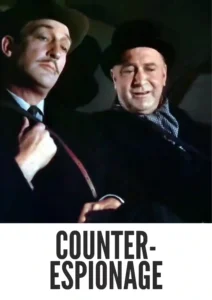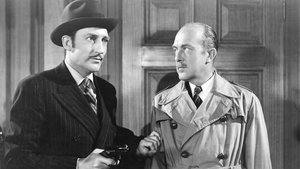Video Sources 0 Views

Synopsis
The Lone Wolf vs. Nazi Spies: Counter-Espionage (1942) in Vivid Color

Experience Counter-Espionage, also known as Contra-spionaj, a captivating spy thriller from 1942, now beautifully colorized for a modern viewing experience. Starring Warren William as the Lone Wolf, this film plunges you into the heart of wartime London as he tracks down German spies during the Blitz. Directed by Edward Dmytryk, this adventure is a thrilling blend of suspense, mystery, and patriotic fervor. Perfect for fans of classic thrillers and those seeking a dose of wartime intrigue, this HD download brings a thrilling piece of cinematic history to your screen.
Counter-Espionage Storyline: London Under Fire, Secrets Unveiled
Counter-Espionage follows the Lone Wolf as he navigates the dangerous world of espionage in London during the German bombing raids. When top-secret plans fall into the wrong hands, it’s up to the Lone Wolf, with the assistance of his ever-reliable valet, Eric Blore, to uncover a Nazi spy ring and prevent the destruction of England. He must clear his name with Scotland Yard Inspector (Thurston Hall), and navigate the help of a woman, Hillary Brooke, who first suspects him.
Movie Cast
The film features a talented cast of actors who bring this wartime story to life:
- Warren William as The Lone Wolf
- Eric Blore as the valet
- Hillary Brooke as the suspicious woman
- Thurston Hall as the Scotland Yard inspector
- Forrest Tucker as one of the baddies
- Morton Lowry as one of the baddies
Movie Genre
Counter-Espionage falls into the genre of spy thriller, with elements of mystery and wartime adventure.
Historical Context: Wartime Cinema
Released in 1942, Counter-Espionage reflects the anxieties and patriotic sentiments of the time, showcasing the fight against the Nazi menace on the home front.
Colorization Details
This colorized version of Counter-Espionage has been meticulously restored using modern digital techniques, enhancing the visual appeal while preserving the film’s original atmosphere of mystery and suspense. The colorization process involved carefully analyzing the grayscale tones of the original black and white footage and assigning appropriate colors to each scene. This painstaking process brings new life to the characters and settings, making the story even more engaging for modern audiences.
Technical Details
- Director: Edward Dmytryk
- Writers: N/A
- Stars: Warren William, Eric Blore, Hillary Brooke
- Production Company: N/A
- Distributed by: N/A
- Runtime: 1 hour 13 minutes
Technical Specifications
- Download Format: MP4
- Resolution: HD (1080p)
- Compatibility: Compatible with most devices, including smartphones, tablets, computers, and smart TVs.
Reviews and Critical Reception
Counter-Espionage is a solid entry in the Lone Wolf series, offering a thrilling and suspenseful adventure set against the backdrop of wartime London.
FAQs
- Q: What is Counter-Espionage about?
- A: Counter-Espionage is about the Lone Wolf tracking down German spies in London during the Blitz.
- Q: Is this version of Counter-Espionage colorized?
- A: Yes, this version has been professionally colorized to enhance the viewing experience.
- Q: What is the download format?
- A: The download format is MP4, which is compatible with most devices.
- Q: What resolution is the download?
- A: The resolution is HD (1080p), providing a high-quality viewing experience.
Download Now in HD!
Watch Counter-Espionage Today!











